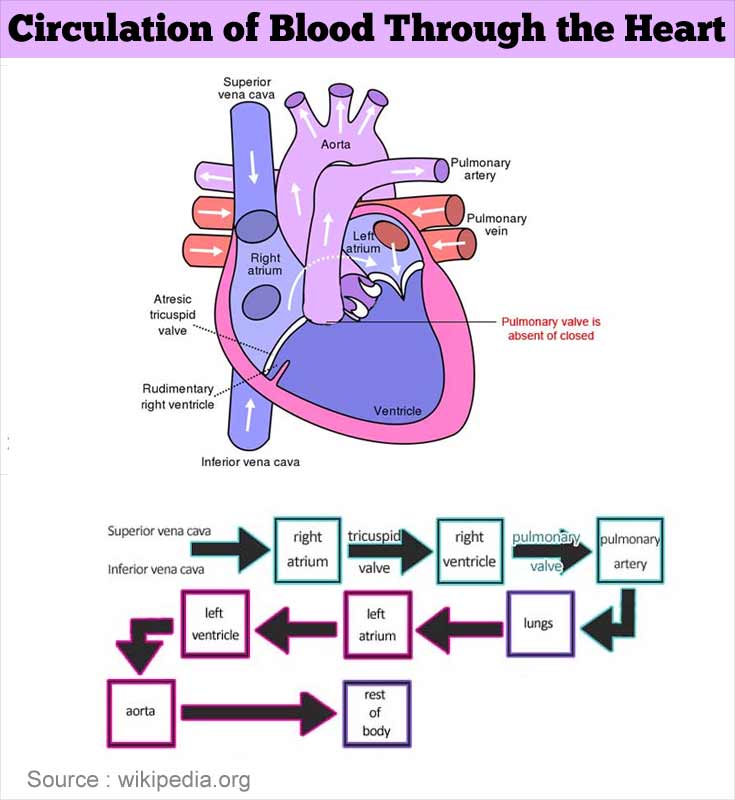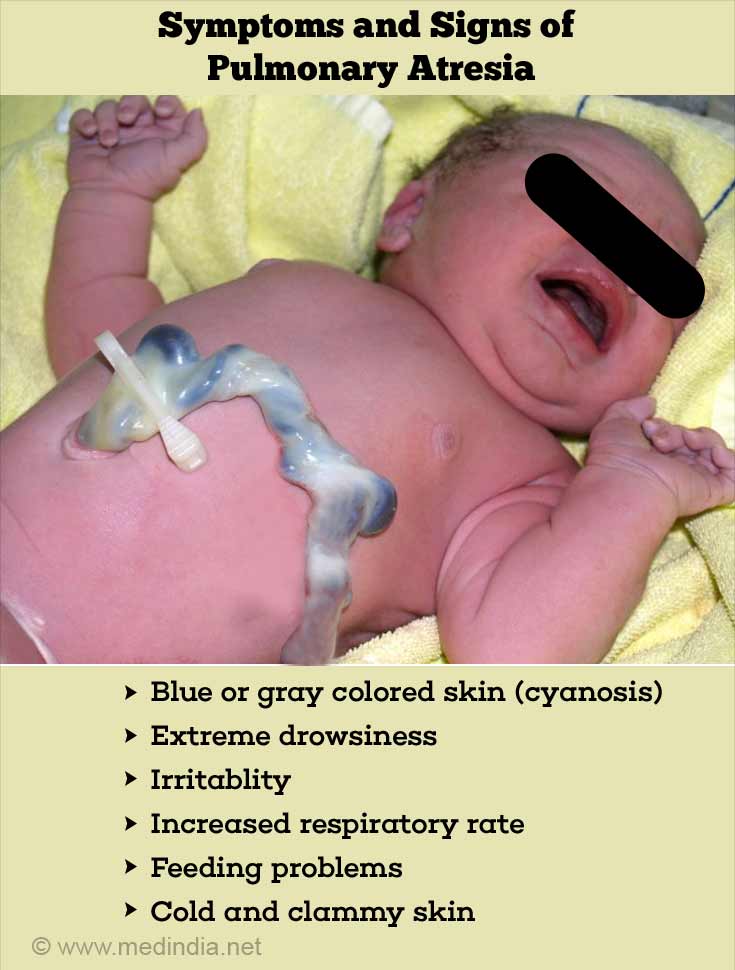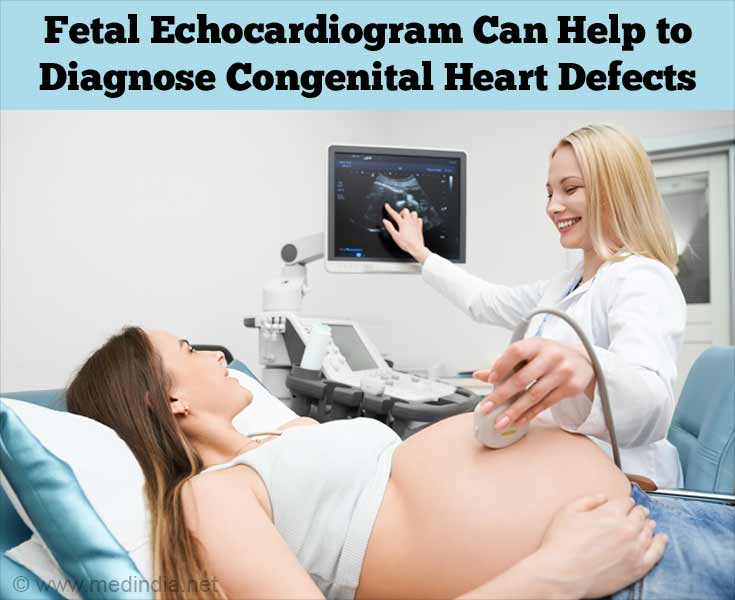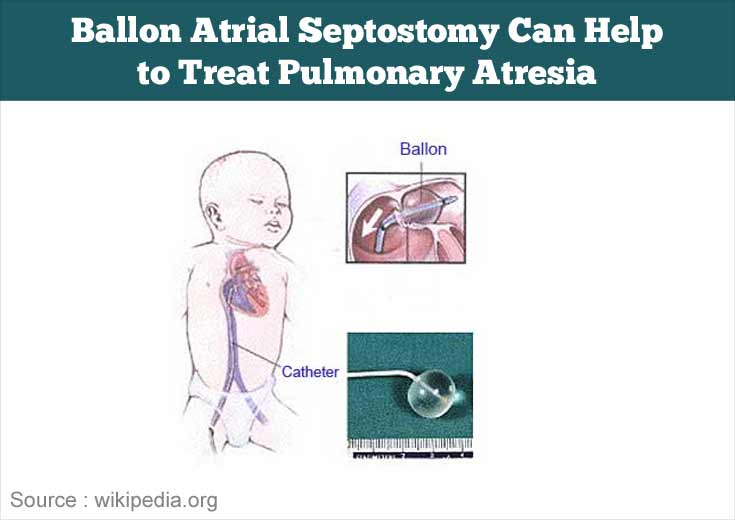- Facts about Pulmonary Atresia - (https://www.cdc.gov/ncbddd/heartdefects/pulmonaryatresia.html)
- What is pulmonary atresia? - (http://www.stanfordchildrens.org/en/topic/default?id=pulmonary-atresia-pa-90-p01809)
What is Pulmonary Atresia?
Pulmonary atresia is a congenital (present at birth) heart defect where the pulmonary valve that regulates blood flow from the right ventricle to the lungs is absent/poorly developed and therefore blood from the right ventricle cannot enter the lungs.
Since a baby born with pulmonary atresia may need surgery or other procedures soon after birth, it is considered a critical heart defect.
Normal Blood Circulation - In Brief
To understand what happens in pulmonary atresia, it would help to know in brief about the normal blood circulation.
- The human heart is a four-chambered organ. The two upper chambers are the right and left atria. The two lower chambers are the right and left ventricles.
- The right-sided heart chambers contain impure venous blood and the left side contains pure blood.
- Impure venous blood from the various organs returns to the right side of the heart.
- This impure deoxygenated blood flows from the right ventricle via the pulmonary valve into the pulmonary artery and reaches the lungs.
- In the lungs the impure blood gets oxygenated (from the air we breathe in) and becomes purified.
- This oxygenated blood is delivered to the left side of the heart to be pumped out to all the organs of the body via the major blood vessel, the aorta.
- Once the organs use up the oxygen for their activities, the impure deoxygenated blood returns once again to the right side of the heart, and the entire process is repeated.
Thus in pulmonary atresia, the impure blood from the right ventricle is unable to reach the lungs to be purified, and as a result, the tissues of the body suffer from lack of oxygen.
Alternative Routes for the Blood to Reach Lungs in Pulmonary Atresia
In pulmonary atresia, blood cannot directly flow from the right ventricle into the pulmonary artery - therefore it must use other routes to bypass the atretic pulmonary valve.
- The foramen ovale is a natural opening between the right and left upper chambers of the heart during pregnancy that closes typically after the baby’s birth. Often it remains open in pulmonary atresia to permit blood flow to the lungs.
- The ductus arteriosus is a blood vessel that connects the pulmonary artery to the aorta before the baby is born and it also usually closes after birth. Doctors may give drugs to the baby to keep the baby’s ductus arteriosus patent (open) even after birth.

What are the Types of Pulmonary Atresia?
There are typically two types of pulmonary atresia, depending on whether or not the baby also has an associated condition called ventricular septal defect (a defect in the wall that separates the two lower heart chambers or ventricles).
Pulmonary atresia with an intact ventricular septum
- In this condition, the wall, or septum, between the ventricles remains intact
- When the heart is developing inside the womb, very little blood flows in and out of the right ventricle (RV), and therefore the RV is unable to develop fully and remains very small
- Because the RV muscle is poorly developed, it is unable to contract and force blood into the pulmonary artery
- The artery which usually carries blood out of the right ventricle, the main pulmonary artery (MPA) also remains very small since little or no blood reaches it from the RV
Pulmonary atresia with an intact ventricular septum is a rather uncommon congenital defect. Without intervention in the first few weeks of life, it results in death in 85% of babies by six months of age.
Pulmonary atresia with a ventricular septal defect
- In this type of pulmonary atresia, the ventricular septal defect (VSD) allows blood flow into and out of the right ventricle (RV)
- Therefore the RV can develop during pregnancy and does not remain small or ineffective in pumping blood out into the pulmonary artery
Pulmonary atresia plus VSD accounts for 1% to 2% of all congenital heart defects with a frequency of 7/100,000 live births.
What are the Causes of Pulmonary Atresia?
As with most congenital heart diseases, the exact cause of pulmonary atresia is not known. It is commonly associated with another type of congenital heart defect called a patent ductus arteriosus (PDA)
Heart defects also are believed to be caused by a combination of genetic and environmental factors, such as the substances the mother comes in contact with in the environment (infections), or what the mother eats or drinks, or certain medications she takes.
What are the Symptoms and Signs of Pulmonary Atresia?
Pulmonary atresia symptoms may show up within hours to several days after birth. These include the following -
- Blue-or gray colored skin (cyanosis) due to decreased oxygen content in blood
- Extreme drowsiness and poor activity
- Irritability
- Increased respiratory rate or shortness of breath
- Feeding problems, such as becoming tired or sweating while eating
- Cold and clammy skin

How do you Diagnose Pulmonary Atresia?
Before Birth
During pregnancy, an ultrasound test is done on the mother to check for congenital defects and other conditions. Pulmonary atresia might be detected during this ultrasound which is an imaging test that uses sound waves.
If pulmonary atresia is suspected, the doctor can request a fetal echocardiogram to confirm the diagnosis. A fetal echocardiogram is an ultrasound imaging especially of the baby’s heart and major blood vessels that is performed during the pregnancy. This test can identify defects in the structure and function of the fetal heart.

After Birth
Following the birth of the baby, history given by parents and family members and physical examination conducted by the doctor may raise a suspicion of congenital heart disease.
- The most common test to confirm the diagnosis is an echocardiogram of the baby’s heart that will reveal structural and functional defects in the heart
- A chest x-ray may sometimes show the presence and extent of pulmonary atresia
- Sometimes, cardiac catheterization (inserting a thin flexible tube into a blood vessel and guiding it to the heart) may help to confirm the diagnosis by visualizing the inside of the heart and measuring oxygen levels and chamber pressures, as well as the pulmonary artery and aortic pressures
- An electrocardiogram (EKG), which measures the electrical activity of the heart may also be used to make the diagnosis
- Pulse oximetry a test used to measure oxygen saturation of the blood may identify infants with critical heart disease such as pulmonary atresia before symptoms appear
How do you Treat Pulmonary Atresia?
The baby will need urgent medical attention once symptoms develop. The choice of procedures or surgery depends on the severity of the baby’s condition.
Medications
Most babies with pulmonary atresia will require medication to keep the ductus arteriosus open even after birth. A prostaglandin administered intravenously will prevent the closure of the natural connection (ductus arteriosus) between the pulmonary artery and the aorta. This is not a permanent solution and will allow blood blow into the lungs and buy time until the pulmonary atresia is surgically repaired.
Catheterization Procedures
Occasionally repair may be possible by introducing a long thin flexible tube into the leg vessel and guiding it into the heart. It is a diagnostic procedure, but can also be used as an initial treatment method for certain defects.
Radiofrequency ablation and balloon valvotomy
In this procedure, the doctor applies a small amount of energy (radiofrequency ablation) or employs a wire to make a small hole at the center of the pulmonary valve and then use a balloon to widen the lumen of the valve.
Balloon atrial septostomy
A balloon can also be used to expand the natural gap (foramen ovale) in the wall between the upper two chambers of the heart. This hole usually closes shortly after birth. Enlarging it increases the amount of blood available to travel to the lungs.

Stent placement
A rigid tube (stent) placed in the ductus arteriosus (which normally closes after birth) keeps it open and allows blood to reach the lungs.
Open Heart Surgery
If pulmonary atresia is associated with VSD, and the right ventricle is small, then the operation requires the closure of the VSD and placement of a connection from the right ventricle to the pulmonary artery to reach the lungs.
If a baby with pulmonary atresia has a small right ventricle with an intact ventricular septum, a series of staged surgical procedures may be necessary where blood flow is redirected to the lungs via various surgical connections -
- The first operation is positioning of a Blalock-Taussig shunt (or BT shunt) that allows blood to flow to the lungs once the natural patent ductus arteriosus closes.
- The second operation is a Glenn procedure, where the large vein (superior vena cava) draining the upper limb venous blood into the right side of the heart is also connected directly to the right pulmonary artery.
- In the third and final Fontan procedure, the large vein draining the venous blood of the lower limb (inferior vena cava) is connected to the right pulmonary artery.
In cases with severe heart damage, a heart transplant may be required.
What are the Complications of Pulmonary Atresia?
- Delayed growth and development of the child
- Heart failure – the inability of the heart to pump blood
- Infective endocarditis - infection of the heart valves
- Stroke - brain damage due to clot in the cerebral vessels blocking blood flow
- Death
Health Tips and Living with Pulmonary Atresia
- Maintain good diet and nutrition
- Keep the child as active as it is possible with the condition
- Maintain antibiotic cover to prevent infective endocarditis
- Maintain good oral hygiene with regular dental check-ups
- Be regular with doctor visits
- Be up to date on vaccinations
- Talk to teachers at school about learning and developmental difficulties
- Seek psychological support to help with emotional problems
- Join a support group to share and learn from experiences of other parents






